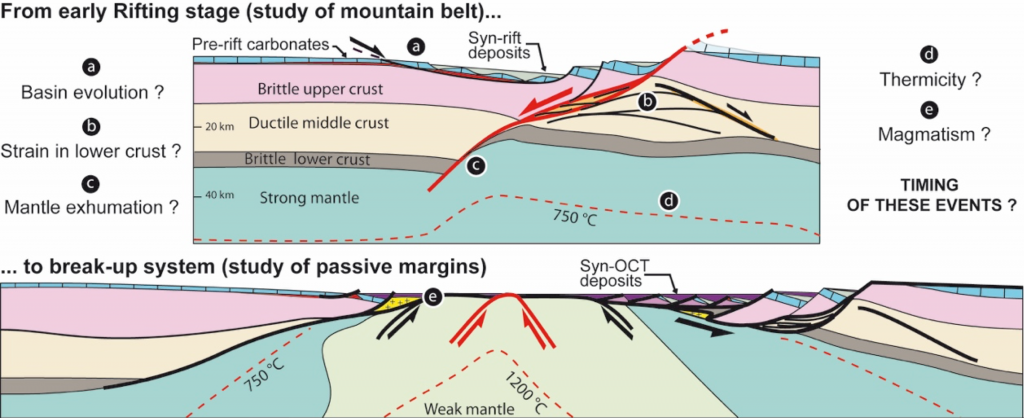The orogenic cycle is at the center of the group’s research. We work, in particular, on the acquisition of rheological properties of the lithosphere during thinning because they will control the following orogenic systems in the Wilson cycle in terms of orogenic growth and topographic evolution.
Participants: Y. Denèle (coord.), D. Chardon, F. Christophoul, A. Maillard, F. Mouthereau, D. Rouby, M. Aretz, E. Nardin, V. Regard.
Axis 1: Rheology and deformation partitioning in rifted margins
We are working on the rheological evolution during rifting, and the 3D partitioning of the deformation. The aim is to understand the variability of the geometry of continental margins in 3D, i.e. both the processes of continental stretching and their interactions with surface processes.
Our competences couple a land/sea approach (continental and oceanic domains), tectonics and dynamics of sedimentary basins via a field approach and geodynamic modeling. They allow us to answer fundamental questions on sites covering a large variety of geometries of present or fossil margins, such as the Equatorial Atlantic (D. Rouby and D. Chardon), the Balearic/Mediterranean (A. Maillard) or the fossil margins and rifts exhumed in the Pyrenees and other rifted segments of the Iberian plate (Y. Denèle and F. Mouthereau).

Axis 2: Early stages of orogenic construction
Orogenic construction, especially for the peri-Tethyan (i.e. Alpine type) mountain ranges, resulting from the inversion of rifted margins is strongly impacted by inheritance. We therefore seek to understand the three-dimensional complexity resulting from inheritance (transfer zones, segmentation, termination etc….) as well as the impact of a very low mechanical level (evaporites in the pre-rifted margin series).
We integrate tectonic, low-temperature thermochronological, detrital and in-situ studies with quantitative paleogeographic and kinematic reconstructions including isostatic compensation of thinning and shortening.
